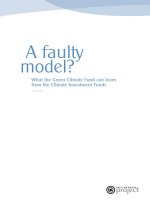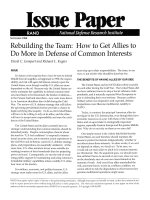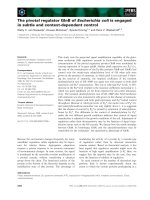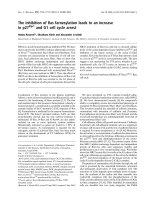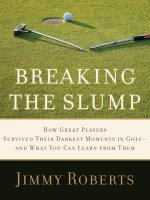Breaking the Slump: How Great Players Survived Their Darkest Moments in Golf—and What You Can Learn from Them pot
Bạn đang xem bản rút gọn của tài liệu. Xem và tải ngay bản đầy đủ của tài liệu tại đây (1017.92 KB, 259 trang )
Breaking the
Slump
How Great Players Survived Their
Darkest Moments in Golf—and What
You Can Learn from Them
Jimmy Roberts
Breaking the
Slump
How Great Players Survived Their
Darkest Moments in Golf—and What
You Can Learn from Them
Jimmy Roberts
To Ralph and Betty for showing me the way.
To Jackson, Aidan, and Daniel for filling
each step with such joy.
And most of all to Sandy for
everything . . . and so much more.
Contents
Introduction 1
chapter 1 PAUL AZINGER 11
chapter 2 JACK NICKLAUS 26
chapter 3 SCOTT VERPLANK 38
chapter 4 DAVID DUVAL 49
chapter 5 DAN JANSEN 61
chapter 6 JUSTIN ROSE 71
chapter 7 GREG NORMAN 87
chapter 8 PHIL MICKELSON 101
chapter 9 BEN CRENSHAW 118
chapter 10 JOHNNY MILLER 129
chapter 11 DAVIS LOVE III 139
contents
v
chapter 12 JUSTIN LEONARD 149
chapter 13 GEORGE H. W. BUSH 163
chapter 14 ARNOLD PALMER 174
chapter 15 DOTTIE PEPPER 183
chapter 16 TOM WATSON 195
chapter 17 STEVE STRICKER 208
chapter 18 HAL SUTTON 221
Epilogue 233
Acknowledgments 247
About the Author
Credits
Cover
Copyright
About the Publisher
i
Introduction
Slump
“I’m one bad swing away from antiquing!”
I
don’t know that the details really matter all that
much. I imagine it’s happened to anybody who’s ever
been foolish enough to allow this game to matter to
the extent we all do.
I am in a slump. I’d have to say it’s considerable, al-
though who has ever been in a slump they didn’t think
was considerable? This one is especially vexing because
it’s the “throw your clubs in the lake, never gonna play
again” variety. But then again, if you play this game, I
imagine you fall into one of two categories when it comes
to this type of slump: either you’ve had one (at least one),
or you’re going to have one (at least one).
Slumps are terrible things. Just when golf has allowed
you to achieve a relative level of competency, just when
you’ve actually started to feel good about your game, they
arrive out of nowhere like Marley’s ghost to rattle their
Introduction
2
chains and terrify. A slump will cause the perfectly sane
to talk out loud to no one in particular and without an
ounce of shame. A slump can infect every aspect of your
otherwise healthy life and turn even the most optimistic
among us into Chicken Little.
Just as you don’t talk to a major leaguer about a no-
hitter while he’s pitching one, you don’t imply that a
golfer might be suffering a slump unless it’s actually
sighted, confirmed, and, most importantly, admitted (as
if the word itself might have some type of self-actualizing
mystical power). PGA Tour players can be very touchy
on this subject. Tiger Woods spent a good three months
in the winter and spring of 2001 glowering at anybody
who had the audacity to wonder if he might be slumping.
He’d gone winless for one of the longest stretches of his
young career, but then rattled off three straight triumphs
at Bay Hill, the Players, and the Masters. That year I got
the “wrong place, wrong time” award when Woods, after
winning the Players Championship, turned contemptu-
ously to me in the post-tournament interview and said,
“Nice slump, huh Jimmy?” then sullenly stormed off.
(For the record, many people that fall had suggested
Woods was enduring a slump, but I was not one of them.
The closest I got was joking a few weeks earlier during the
Tour’s stop at Doral that Woods was in a slump about the
same way the Beatles were slumping in any given week in
1964 when they didn’t have a number one record.)
On and off, I’ve been playing golf since I was seven.
Introduction
3
When I was fourteen, I won our club junior nine-hole
tournament. When I was forty-two, I had my first (and
so far only) hole-in-one. Those two facts might lead you
to believe I can play, that perhaps I’m one of those awful
people who plops down next to you in the grill room with
a dour face, complaining about the “horrible” 79 he’s just
chopped his way through.
Actually, where I come from, there’s no such thing
as a horrible 79. I am mediocre at best. My greatest ac-
complishment in the game was vowing to get my USGA
Handicap Index down to single digits before my fiftieth
birthday—and actually doing so.
I grew up a child of relative privilege in Westchester
County, New York, about forty-five minutes north of
New York City. We belonged to a country club, and
every weekend my father played. He had the most amaz-
ing swing: the takeaway was the slowest, most deliberate
move you could ever imagine. But once he got to the top,
there was a frightening explosive contraction that made
you think perhaps someone had fired a gun at the swing’s
apogee—only my father had heard it—and it had scared
the shit out of him. Think a slower version of Ernie Els
on the backswing and a faster version of Hubert Green
going the other way. Dad was frustrated by the game,
but dedicated. One year he won the “C” flight of the club
championship. After Dad’s teaching me didn’t quite work
out (disaster), I ended up on the lesson tee with the head
pro. Jack Kiley had slicked-back hair and wore Sansabelt
Introduction
4
pants. I imagine he had just the look that made all the
Laura Petrie–type moms swoon just a little bit. I was a
fairly athletic kid, and he helped me to develop a reason-
able swing. But it was one that contained a near-fatal
flaw: way too much lateral movement. In the parlance of
the industry, there was too much sliding, and not enough
rotation. The result was a slice I would fight for the next
thirty-five years.
As a teenager I settled into a niche of comfortable
incompetence. I shot mostly around 100, never serious
enough about the game to pursue a remedy for a swing
that grew more and more broken. I loved the game, loved
being on the course with my friends, but life was too busy
to devote the requisite time to correct the problem. Some-
thing as simple as changing my grip just felt like more
trouble than it was worth. My diseased swing felt com-
pletely natural, and while changing it might eventually
yield results, it wouldn’t be fun. It would be work. So I
dawdled along in the neighborhood of three digits until a
reason arose for me to change things.
In the spring of 2000, I joined NBC Sports. I would cover
Wimbledon and the Olympics, major league baseball, and
a few other things, but mostly I would cover golf.
That meant joining a broadcast team that not only
loved the game but also played it at every possible oppor-
tunity. For the twelve previous years at ESPN and ABC,
Introduction
5
I might have played a total of fifteen rounds of golf while
on the road covering big events. NBC was a totally differ-
ent animal. The first event I worked for my new employer
was the 2000 U.S. Open at Pebble Beach. In my first four
days on the job, I played four rounds of golf: Spanish Bay,
Del Monte, Cyprus Point, and Pebble Beach. The round at
Pebble on my very first day of work proved to be the slap
in the face that changed my attitude about the game.
That Saturday morning, we recorded our U.S. Open
preview show. I joined host Dan Hicks and expert com-
mentators Roger Maltbie, Gary Koch, and Mark Rolfing
as we shot the on-camera portions of the show just off of
Pebble’s ninth green. When we finished, producer Tom
Roy clapped his hands and shouted, “All right, good job
everybody. We’ve got two foursomes. We better hustle
over to the first tee.”
Now there are a few things to understand about what
was about to happen. I was going to play golf with my
new colleagues. Not only was this one of the hardest golf
courses I had ever seen, but the custom among this group
was to play it all the way back: ALL THE WAY. Those in
the group who weren’t former touring pros like Maltbie
and Koch were just really good, like Tom Randolph, our
co-producer, who was an all-America, honorable men-
tion at UCLA, and captain of a golf team that would in-
clude future PGA Tour winners Corey Pavin, Steve Pate,
and Tom Pernice. Roy, my boss, was the son of a golf
pro, who himself once harbored an ambition to try and
Introduction
6
play the Tour. So here I was, nervous and overmatched.
I’d like to say the next four and a half hours went well.
They didn’t. “Catastrophe” would have been a charitable
characterization. Talk about a good walk spoiled: the
low point came on the twelfth hole. As I stood on the
tee box of the par three, out popped Maltbie, who had
decided not to play. Just as I sent a hozel-rocket scream-
ing to the right at shoetop level, I looked up to see him
laughing hysterically. And there in his hand was a small
camera. I wish it was only humiliating, but it seemed so
much worse. Hole by hole, I felt my credibility with my
new colleagues slowly evaporating. As I walked alone to
find my ball I could only imagine what they were think-
ing: “Why would we ever hire this clown? He could be the
worst golfer I’ve ever seen.”
Beautiful afternoon, incredible place, and it was the
worst single day I’ve ever had on a golf course. I vowed
that afternoon I would never be humiliated like that again.
And so like some golfing Rocky Balboa, I started looking
for museum steps to run and sides of beef to hit. I took
lessons with Harvey Lannak, an incredible instructor at
Westchester Country Club, and I watched my friend Gary
Koch closely each time we went to play, and then leaned
heavily on his expertise. I spent hours on the range at PGA
Tour events watching the best swings on Planet Earth and
then ran back and tried to duplicate what I had observed.
Butch Harmon looked at my swing. So did David Ledbet-
Introduction
7
ter and Peter Kostis. But mostly I just beat balls. My climb
out of the morass was long and ugly.
A trip to play a handful of the great courses on the
east end of New York’s Long Island comes to mind. The
Hamptons is a bucolic playground for the well-to-do,
known for many genteel country pursuits aside from ex-
clusive golf courses like Shinnecock, National Golf Links,
and the Maidstone Club. So when another feeble and
cringe-worthy effort dribbled off the heel of my driver, I
let out a primal and frustrated scream that still haunts me
among my golf buddies today:
“I’m one bad swing away from antiquing!” I exploded.
But slowly—very slowly—I got better, and the watershed
moments took on an altogether different character.
One year, I played in the Pro-Am at the Arnold Palmer
Invitational at Bay Hill. I went to the range early and
tried to find the most distant corner in which to warm
up. Just as I was almost through, I heard a mocking
nasal twang: “Oh, this ought to be good. Let’s see what
you got.”
It was Fred Couples, and he had rounded up a hand-
ful of other players. I would have much rather simply left
them with the mistaken notion I was a good player than
hit even one shot and demonstrate I was not, but they
were having none of it. Finally, I stuck a tee in the ground
and, with sweat pouring down my forehead, hit a very
respectable drive with a nice soft fade. I picked up the tee,
Introduction
8
put my driver back in my bag, and confidently strutted
past the now-silent golfers.
“So, Fred,” I said. “I guess the next time you shoot 79,
I can insist you stop by to talk with me, right?”
I didn’t suck anymore.
And that’s the world I lived in for a few years. Golf was
exciting. I didn’t count my score on each hole in relation
to “fives” anymore. The game was now about the pur-
suit of par. Now that I could hit the ball, I worked on the
subtleties of the game: bunker play, trajectory, flop shots.
One day I looked up on the range and realized my ball
flight was no longer left to right. My god, I was drawing
the ball!
I wasn’t going on tour, but I was solidly in the mid-
eighties. My handicap sank to 9.8. Life was good. And
then something happened.
That nice draw suddenly turned into a hook, and then a
vicious hook. My driver, which had always been the most
dependable club in my bag, betrayed me and started pro-
ducing the most ungodly thing: a short, high pull—with a
tail! I ran to Harvey for help, and he fixed things tempo-
rarily, but a day later, I was a mess again. Marley’s ghost
had arrived.
I haven’t yet figured this thing out, but I know I will. I
hope I will. Intellectually, I’m confident I can get through
it, but despite what I’ve found myself saying on television
Introduction
9
dozens of times, there is absolutely no cerebral compo-
nent to success in this game.
It’s all voodoo.
And just as we all stand on the range looking into each
other’s bags to see what type of equipment the next guy
is using, I want to know what kind of voodoo others have
summoned in their darkest hours. So I packed my bag and
headed out to collect slump stories. If for some reason I
can’t beat this thing by myself, maybe I can learn from
somebody else. I went knocking on the doors of not only
golf’s legends but also those enormously successful and
celebrated in other endeavors who also just happen to be
obsessed with the game as well.
What was your worst slump? Did you ever lose hope?
How did you pull yourself out of it? How long did it take? I
had a million questions. Perhaps the answers would shine
a light for me on the path out of the darkness. Maybe they
will for you too.
Chapter 1
PAUL A ZINGER
“Confidence is something that when you have it,
you never think you’re going to lose it, and when you lose it,
you never think you’re going to get it back.”
I
t is a sunny late September morning in Bradenton,
Florida, and I am standing in line at Starbucks with
Captain America. I go for a decaf, but Paul Azinger
prefers something stronger. As if he needs it. He’s buzz-
ing anyway.
“Way to go,” an older woman yells at Azinger a few
minutes later from the window of a weathered SUV.
“Congratulations!”
Much to Azinger’s delight and surprise, the scene is re-
peated a handful more times as we sit sipping our coffee
at an outdoor table. “There’s a lot going on that’s not
good,” he says. “I think it’s kind of a scary time, and this
was uplifting for a lot of people.”
Eight days earlier, using a blueprint for team building
that might wow the people at Harvard Business School,
Azinger engineered a win for the United States at the
breaking the slump
12
Ryder Cup in Louisville, Kentucky. It had been nearly
a decade since the last United States win, and America’s
fortunes in the competition had become something of a
hyper-scrutinized obsession in the insular world of golf.
So instead of sipping coffee with me on a lazy Monday
morning on the Gulf Coast of Florida, Azinger could be
in Los Angeles doing the Tonight Show with Jay Leno,
or taping a guest spot with Ellen DeGeneres or Jimmy
Kimmel, but he has turned it all down to come back home
and just let it sink in.
“I feel like I spent the last two years slowly pulling back
the string of a bow and I finally let it go.”
With the Cup in tow, he will venture across town later
in the week to throw out the first pitch in Game Two of
the first ever major league baseball post-season series for
his hometown Tampa Bay Rays. As we sit talking, his
phone rattles incessantly. Hundreds of text messages,
voice-mails, and e-mails have yet to be returned, includ-
ing one from the president of the United States. “I don’t
want to call him back yet. He’s so busy up there. I don’t
want him to feel obligated to take my call. He’s got more
important things to do.”
The night before, we walked out his back door and
onto the dock, which leads 382 feet out into Tampa Bay.
The sky was clear and the night was silent, except for
small waves lapping hypnotically against the pylons. Az-
inger looked west towards the Gulf of Mexico and sighed.
“People always ask me why in the world I would want to
Paul Azinger
13
live in Bradenton. There’s nothing here. ‘You’re right,’ I
tell them. ‘You don’t want to come here.’ ”
He laughs, and we head back to the house. Life is im-
possibly good. Three months ago, he walked his oldest
daughter down the aisle, and just seven days earlier, he
cunningly led the U.S. team to a Ryder Cup win over a
side captained by his long-time adversary and irritant,
Nick Faldo, the man with whom he’d often sarcastically
dueled as television commentators for ABC Sports. Many
in American golf would have you believe that the Louis-
ville matches were a matter of life and death. Azinger is a
vicious competitor, and he desperately wanted to win the
Ryder Cup, but it was hardly a life-and-death affair. Who
in golf could possibly know that any better?
There was a time not too long before when Azinger’s ce-
lebrity wasn’t about helping others do their best, or com-
menting about it on TV, but rather doing it himself.
In 1987, he was the PGA of America’s Player of the Year.
It was the start of a muscular seven-year stretch during
which he collected eleven wins on Tour and finished every
year except one in the top ten on the money list. The year
he didn’t, he finished eleventh. “If I wasn’t the best player
in the world, I was certainly the hottest,” he says.
He might have also been the biggest surprise.
There are successful pros like Nicklaus or Mickelson
or Woods who exploded through amateur and junior golf
breaking the slump
14
and collected every credential there was. There are play-
ers like Steve Stricker and Davis Love who had modest
but successful amateur careers before they made a name
in professional golf. And then there are the real rarities—
players like Azinger.
“I couldn’t break 80 two days in a row my senior year
in high school,” Azinger remembers. “I suppose I prob-
ably could, but if I did, I’d run home and tell someone.”
The son of an Air Force navigator who flew C-141s in
Korea and Vietnam, Azinger learned to play golf mostly
on military bases. His earliest memory of the game is
riding atop the pull cart his dad, Ralph, dragged around
the course at Homestead Air Force Base in south Florida
when Paul was three years old.
“My dad was a single-digit handicap,” he says, “but
my mom was better than him. She got down to like a four
or five handicap.”
Aside from winning several state and regional tourna-
ments, Jean Azinger’s claim to fame was playing—and
with great distinction—in an exhibition with the hall-
of-famer Patty Berg in 1959. Jean chipped in three times
during the round, a round she played while seven months
pregnant—with Paul.
Initially, though, her son’s in utero training didn’t seem
to make much of an imprint. Paul Azinger was mostly an
indifferent high school golfer.
“None of my friends played golf,” he says. “I just wasn’t
into it.”
Paul Azinger
15
Upon graduating from Sarasota High School in the
spring of 1978, he didn’t get a single scholarship offer
and ended up at Brevard Community College. “I knew I
wasn’t any good at golf,” he says. “Sometimes you think
you’re good and you’re not. I knew I wasn’t that good.”
But things started to change in the summer of 1979,
when Azinger went away from home for the first time
ever and took a job as a counselor at Arnold Palmer’s
Golf Academy at Bay Hill in Orlando. “Actually we were
more like babysitters,” he says. “We’d pick these campers
up, and they’d stay two weeks, and then we’d take ’em
back to the airport and pick up a whole new batch. I was
kind of a gofer for the [teaching] pros. We took care of
the kids after the day was over. Volleyball, swimming,
that type of thing.”
The job paid $80 a week plus a room, but the side ben-
efit was that whenever he could steal the time, Azinger
could use the facilities. That summer, he says he “lived
and breathed the game.”
“Bay Hill’s such a hard golf course. All of a sudden, I
went back to college and I’m playing these courses, and I
murdered ’em.”
But also, for the first time in his life, Azinger got seri-
ous instruction. Jim Suttie, his coach at Brevard, was on
the Palmer Academy staff. And in addition to working
tirelessly with Azinger, Suttie introduced him to a Titus-
ville pro named John Redmond, who would be instru-
mental in his development.
breaking the slump
16
Azinger had arrived at Bay Hill as what he called “the
third man on Brevard’s C team,” but soon after that
summer, he was the school’s number one player. “It was
one of those things where my game changed so much for
the better, so fast,” he says, “that I didn’t realize what was
happening.”
After one more year at Brevard, he moved on to Florida
State, where he started to have his first big-time competi-
tive success, winning the Metro Conference tournament
and the Gator Invitational. But Tallahassee was just a pit
stop, too. “I wasn’t going to get any better there,” he says,
“and academically I was totally uninterested.”
So in the fall of 1981, after one year at Florida State,
Azinger tried his hand at professional golf. Less than two
years after having broken 70 for the first time, he quali-
fied for the PGA Tour at Waterwood National in Texas.
His father convinced nine friends to kick in $3,000 each,
and Azinger was staked to a start. He didn’t exactly ex-
plode out of the gate with confidence.
“I didn’t see myself being able to compete with those
guys,” he says of the players on Tour. “I didn’t think I was
capable—mentally or anything. I thought I was going
to be too nervous a figure. No self-confidence. Self-con-
scious about my swing. Self-conscious about my grip.”
Azinger’s grip. It was the neon sign that immediately
attracted the attention of most knowledgeable people
when they first saw him play. His left hand was rotated
dramatically over the top of the club in an exceptionally
Paul Azinger
17
strong position. No one else at this level held the club in a
remotely similar fashion. Azinger’s grip was like Bob Dy-
lan’s voice—unusual, even eccentric—but it had served
him well.
“I had a couple of players tell me ‘you’ll never be any
good with that grip. You’ve got to change it.’ They were
wrong, but I didn’t know they were wrong.”
That first year on Tour, he earned a total of $10,000
in twenty-one events. He kept his head above water, but
just barely. “My first four years as a pro,” he says, “I had
to file taxes, but I never had to pay anything. I just kept
losing money.”
Then came an odd interlude that would change his
career. Azinger struck up a friendship with a man named
Mac McKee, who had known Azinger’s wife since she
was a little girl. “He told me up front,” Azinger remem-
bers, “ ‘I don’t know one thing about golf, but I know I
can make you a better golfer.’ ”
Azinger had reason to be doubtful. McKee was a re-
tired boxing trainer from Blackshear, Georgia, who over
the years had also earned a living as a carnival fighter.
For a fee you could get in the ring with him and see how
tough you were. He would take on all comers. Despite
being in his mid-sixties, McKee was a physical specimen
who paid great attention to working out, but his hobby
was studying the mind and its part in performance.
“He used to study East German philosophy,” says Az-
inger. “He read books about concentration and hypnosis,
breaking the slump
18
and progressive relaxation, and that type of thing. And he
asked me if I would ever consider going deeper mentally
into the game and taking a different approach.”
At McKee’s suggestion, Azinger began to engage in
heavy visualization. After playing a practice round, he
would sit up in bed at night and imagine, in sequence,
every single shot he would need to play, always hitting the
center of the green. And he did breathing exercises to get
control of his heart rate.
“Breathe in for four counts, and then exhale in a four
count, too,” he says. “So that happened my third year on
Tour. I started to take on a different outlook. Kind of like
Tiger did when he was in third grade.”
His career soon took off. For the first time in four
years as a professional, he earned enough money to
retain his PGA Tour playing privileges, and soon he
found himself on a run that culminated with a playoff
victory over Greg Norman at the 1993 PGA Champion-
ship. Once, standing on the putting green at Westchester
Country Club during that period, he looked up and
laughed after pouring in several consecutive ten-footers
and said to me, “I’m so good. I don’t know how I ever
miss one of these things!”
Azinger was a blend of color, candor, confidence, and
talent. He was at the top of his game when, like an earth-
quake, the ground ruptured beneath his feet and swal-
lowed him whole.
“It was over in an instant,” he says. “Just like that. I
Paul Azinger
19
went from the most confident player, the hottest player,
to just trying to stay alive.”
Plagued by almost constant shoulder pain, which had
started in 1987 and had him living on anti-inflammatory
medication, Azinger finally submitted to a biopsy in the
fall of 1993. The test revealed cancer: non-Hodgkin’s
lymphoma.
“They told me it was pretty much a 90 percent chance
of a complete cure,” he says, “and I felt that you’ve got a
10 percent chance of getting a flat tire on the way home,
and I figured that you never get a flat, so I’m probably
going to be fine.”
More than 1.2 million Americans are diagnosed every
year with some form of cancer. The fortunate ones who
do find themselves with some type of viable and effective
treatment will tell you, though, that as grateful as they
are, the treatment is often worse than anything they could
have imagined. Azinger fell squarely in that category. But
the day of his first treatment, in early December 1993, he
had no idea what all the foreboding was about.
“This is a cakewalk,” he told his friend Payne Stewart,
who’d called that day. “Chemo was easy. It was a snap.”
The recollection is from Azinger’s 1995 autobiography,
Zinger. Around midnight that night, he woke up and got
sick for the first time. Every fifteen minutes for the next
nine hours, his body convulsed.
Azinger had six months of chemotherapy in a hospital
twenty-five hundred miles from his home. “I always flew

